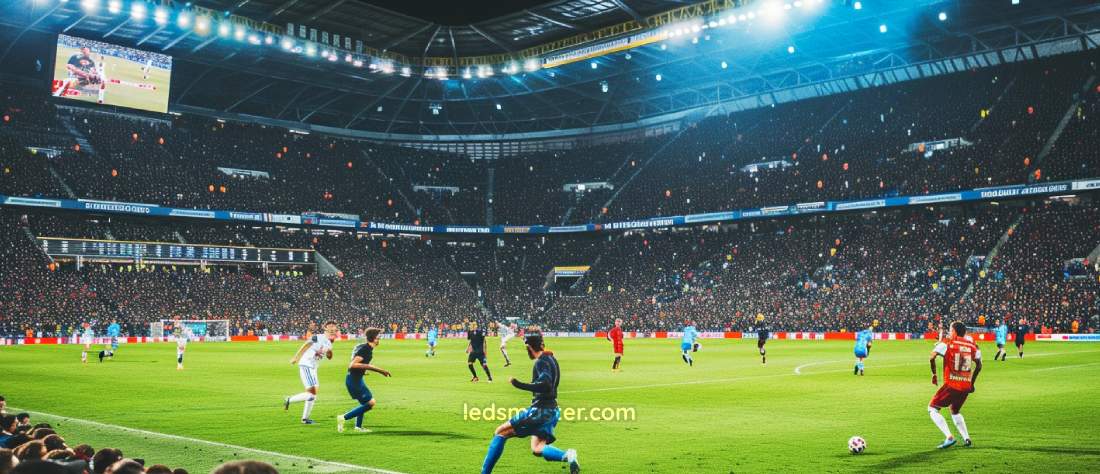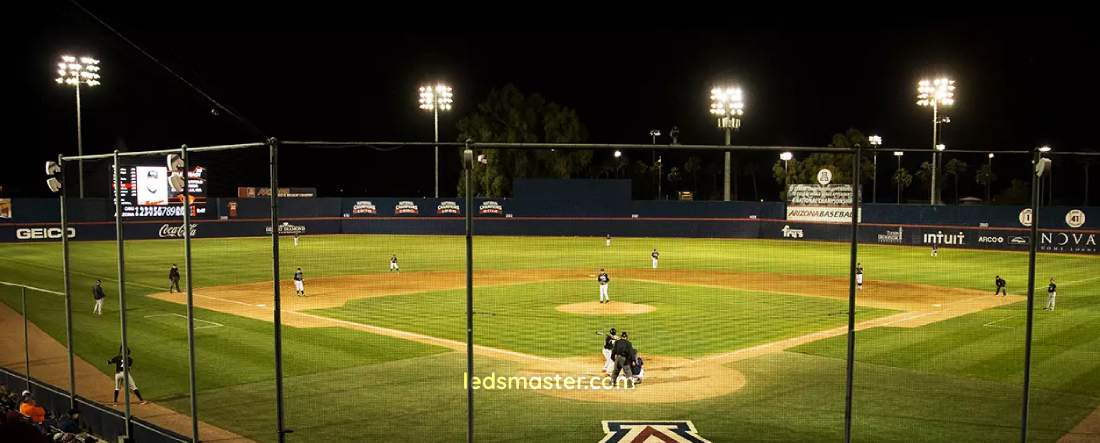Explore our webpage for extensive information on lighting solutions across various sports. You’ll find detailed guidance on illuminating sports venues efficiently while keeping costs under control. Our resources cover tailored lighting strategies and state-of-the-art products designed to enhance visibility, performance, and spectator experience. Whether you’re managing a small local field or a large stadium, we provide insights to help you achieve optimal lighting and cost-effectiveness.
Begin by choosing your sports venue to uncover the specific lighting requirements and solutions needed.
Get your complimentary lighting design today
Sports lighting is integral for providing clear visibility and ensuring the safety of players, officials, and spectators. Adequate lighting enables athletes to perform at their best, reduces the risk of accidents, and enhances the audience’s viewing experience, both in person and through broadcast media. Proper illumination is especially critical for evening events, where natural light is insufficient.
Table of Contents
ToggleDesigning an effective sports lighting system involves several considerations.
Different sports have distinct requirements for illumination levels based on their speed, size of playing area, and the visual demands of the game. High-speed sports like football, baseball, or tennis necessitate brighter lighting to ensure players can react quickly and accurately. For instance, football fields typically require higher illumination levels compared to a lawn bowls green. Light levels are measured in lux, which quantifies the amount of light falling on a surface. Meeting these standards ensures optimal visibility for players and spectators alike.
Uniform lighting across the playing surface is critical to avoid uneven brightness that can create shadows or glare. Uniformity ratios, such as the ratio of maximum to minimum illuminance levels on the field, are used to evaluate and ensure consistent light distribution. This uniformity enhances the visibility of all areas of play, from the corners of a soccer field to the outfield of a baseball diamond, providing a more enjoyable and fair playing environment.
The color temperature of sports lighting impacts visibility and color perception during games. Typically ranging from 4000K to 6500K, sports lighting often uses neutral to cool white light to mimic natural daylight. This range helps players distinguish colors accurately and reduces eye strain, crucial for maintaining focus and performance over extended periods of play.
The Color Rendering Index (CRI) measures how accurately a light source renders colors compared to natural sunlight. For sports lighting, a high CRI is vital, especially for televised events where accurate color representation enhances the viewing experience. By ensuring colors appear true to life, high CRI lighting supports player recognition, improves visual contrast, and enhances the overall quality of broadcasts.
Minimizing glare is essential to optimize visibility and prevent discomfort for players and spectators. Glare occurs when excessive brightness or contrast affects vision, potentially causing distractions or impairing performance. Effective glare control in sports lighting involves precise luminaire positioning, shielding, and beam control to direct light where it’s needed without creating glare. This careful management of light distribution ensures a clear view of the playing area while reducing the strain on both participants and observers.

Historically, sports venues relied on metal halide lamps for their high intensity and ability to emit a broad spectrum of light suitable for illuminating large areas. These lamps were effective but came with significant drawbacks. They required long warm-up times before reaching full brightness, leading to delays in starting events. Additionally, metal halide lamps consumed considerable amounts of energy and had shorter lifespans compared to modern lighting solutions. These factors contributed to higher operational costs and more frequent maintenance requirements, making them less economical in the long term.
The advent of Light Emitting Diode (LED) technology has revolutionized sports lighting systems. LEDs offer numerous advantages over traditional lighting sources. They are highly energy efficient, consuming significantly less electricity while delivering the same or higher levels of illumination. LEDs also boast an extended lifespan, often lasting tens of thousands of hours, which reduces maintenance costs and downtime associated with lamp replacements. Another key benefit is their instant on/off capability, allowing for immediate illumination without warm-up delays. LEDs provide superior light quality with high Color Rendering Index (CRI), ensuring accurate color representation crucial for both players and spectators. Additionally, LEDs offer better controllability, enabling precise adjustment of light levels and distribution tailored to specific sports and events.
High-Intensity Discharge (HID) lamps, including metal halide and high-pressure sodium variants, have been traditional alternatives to LEDs in sports lighting. These lamps are known for their powerful output and have been widely used in various applications. However, HID lamps are gradually being phased out in favor of LEDs due to several factors. Despite their high intensity, HID lamps are less energy efficient compared to LEDs, resulting in higher operating costs over time. They also require longer warm-up times and do not offer the same level of controllability and flexibility as LED systems. As technology advances and the demand for energy-efficient solutions grows, LED lighting continues to dominate the sports lighting market, offering superior performance and sustainability benefits.

Football and soccer fields require robust lighting solutions that provide both high vertical and horizontal illumination. This is essential to accommodate the fast-paced movement of players and the aerial plays typical in these sports. The lighting setup should ensure that the ball and players remain clearly visible from all angles, facilitating accurate gameplay and reducing the risk of injuries due to poor visibility.
Baseball and softball games demand precise lighting focused on critical areas such as the pitcher’s mound, home plate, and outfield. The lighting design must enable players to track the ball accurately during fast pitches and hits, enhancing gameplay and safety. Properly illuminated outfield areas are crucial for fielders to judge and catch high-flying balls effectively.
Tennis courts require uniform lighting that covers the entire playing surface without creating distracting shadows. Consistent lighting helps players see the ball clearly against the court surface and background, ensuring fair play and minimizing visual fatigue during extended matches. Optimal lighting enhances visibility for players and improves the spectator experience by providing clear views of the action.
Indoor basketball courts demand uniform lighting with high color rendering capabilities to support the fast-paced nature of the game. High CRI lighting allows players to distinguish the ball and maintain visual acuity, crucial for accurate shooting, passing, and defense. Properly lit courts also enhance the spectator experience by providing a vibrant and clear view of the game.
Track and field events necessitate bright, uniform lighting across expansive areas to facilitate various athletic disciplines. Different events within track and field may require specific lighting configurations, such as focused lighting for jumping pits and high jump areas. Uniform illumination ensures athletes can perform at their best and provides optimal conditions for both competitors and spectators alike to observe and enjoy the events.
Dynamic lighting controls refer to advanced systems that offer the capability to adjust light levels dynamically based on various factors such as the type of event, time of day, and specific lighting requirements. These systems allow for dimming or increasing light intensity as needed, which enhances energy efficiency by ensuring that only the necessary amount of light is used at any given moment. For example, during practice sessions or lower-intensity events, the lighting can be dimmed to save energy without compromising visibility. This flexibility also accommodates different scenarios and enhances the overall operational efficiency of sports facilities.
Smart lighting systems integrate cutting-edge technologies to enable remote monitoring, control, and automation of lighting systems. These systems can be managed through centralized platforms, allowing facility managers to adjust lighting settings from anywhere. Smart lighting often incorporates sensors that detect occupancy, ambient light levels, and even weather conditions to optimize performance. Automated scheduling and adaptive lighting adjustments contribute to energy savings and operational efficiency, making smart lighting solutions increasingly popular in modern sports venues.
Modern sports lighting designs emphasize sustainability and environmental responsibility. LED technology, known for its energy efficiency and longevity, plays a significant role in reducing both energy consumption and carbon footprint. LED fixtures are designed to provide targeted illumination, minimizing light spillage and reducing light pollution. By using less energy and producing less heat compared to traditional lighting sources, LEDs contribute to lower operational costs and reduced environmental impact over their lifespan.
In today’s sports landscape, televised events require lighting systems that meet stringent broadcast standards. High-definition (HD) and slow-motion cameras used in broadcasting demand flicker-free lighting to ensure clear, consistent visuals. LED lighting systems are preferred for broadcast compatibility due to their ability to provide stable light output without flickering, even when dimmed or adjusted dynamically. This capability ensures that sports broadcasts maintain high-quality visuals, enhancing the viewer experience and meeting the expectations of broadcasters and audiences alike.
Effective sports lighting requires thorough planning and precise execution to ensure optimal performance and safety for athletes and spectators. This process involves several critical stages.
Before designing a lighting system, a comprehensive site assessment is essential. This assessment evaluates various factors such as the layout and size of the venue, the specific requirements of the sport(s) played, and the surrounding environment. Factors like neighboring buildings, natural lighting conditions, and potential light pollution sources are considered to determine the optimal placement and configuration of lighting fixtures.
Based on the findings from the site assessment, the next step is to develop a detailed lighting design. This involves creating a plan that meets industry standards and regulatory requirements while providing optimal illumination for the intended use of the sports facility. Lighting designers select appropriate fixtures based on factors such as light output, beam spread, and energy efficiency. They also determine the mounting height and placement of fixtures to achieve uniform light distribution across the playing surface, ensuring visibility and safety for players.
Professional installation is crucial to ensure that the lighting system is installed correctly, safely, and in compliance with local codes and regulations. Skilled technicians handle the wiring, mounting of fixtures, and integration of control systems with precision. Proper installation not only maximizes the effectiveness of the lighting but also enhances its reliability and longevity. It ensures that the system operates at peak performance from the outset, minimizing potential issues and ensuring consistent light quality over time.
Regular maintenance is essential to preserve the performance and lifespan of sports lighting systems. This includes routine tasks such as cleaning fixtures to remove dirt and debris that can affect light output, checking and adjusting fixture alignment to maintain uniform illumination, and inspecting electrical components for signs of wear or damage. Scheduled maintenance helps identify and address potential issues early, ensuring continuous operation and minimizing downtime. It also includes replacing bulbs or LEDs as they reach the end of their lifespan to maintain optimal light quality and energy efficiency.
By understanding the principles, technologies, and specific requirements of various sports, optimal illumination can be achieved. Advances like LED technology and smart controls offer superior efficiency and flexibility, making modern sports lighting an essential component of any successful sports venue.